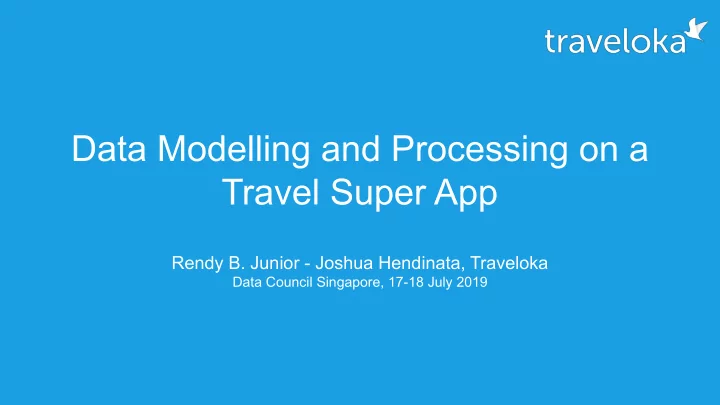

Data Modelling and Processing on a Travel Super App Rendy B. Junior - Joshua Hendinata, Traveloka Data Council Singapore, 17-18 July 2019
#EmpoweringDiscovery
A Travel Super App Company Traveloka is an app that provides wide-range of travel-related product and services, #EmpoweringDiscovery, such as: ● Flight ● Hotel ● Theme parks ● International roaming package ● Activities ● Dine-in
Our technology core has enabled us to scale Traveloka into 6 countries across ASEAN rapidly in less than 2 years. 1,000+ 400+ 8 offices Global employees Engineers Incl. Singapore
Traveloka Data Challenges
Data Model Silos and Dirty Data Everywhere!
Data Model Silos was our Biggest Problem ● We democratized data wrangling ● Each business unit can create their own data model ● So different from one to another ● Hard to analyze across business
Who Suffers the Most The one who suffers most are cross business unit function , such as: ● Marketing ● User Engagement ● Finance Business case example: how can I make a CLV (customer lifetime value) company-wide , if sales data from each business unit is coming in different schema ?
How do we solve Data Silos?
First rule, address the design, not the technology So we address the design problem by designing generic schema across business units Example: sales schema company-wide So then..
But how can we ensure everyone follows company-wide design?
But how can we ensure everyone follows company-wide design? Framework come to the rescue
Super App Schema Framework with Inheritance Schema Inheritance concept: child schema inherit properties of its parent. Central team define the parent schema , all business units must follow
Schema Inheritance Concept Example of inheritance tree.
Schema Inheritance Concept Example of inheritance tree.
We put inheritance into schema all_event.yaml See `parent` field which ties child schema into its more generic parent. It will resolve the schema user_behavior.yaml recursively to the parent. flight_search.yaml
Sample Usage It is very easy to analyse data across all business unit! SELECT user.id, SUM(profit) FROM fact_sales_* GROUP BY 1 fact_order_* is equivalent to fact_order_flight UNION ALL fact_order_hotel and so on
Data Model Silos (solved!) and Dirty Data Everywhere!
Pattern of Dirty Data Business Rule Violation e.g. ● Min/max string length ● Min/max value ● String pattern ● Possible values (enumeration)
Repeated Process Everywhere Those teams end up creating a process to make the data from each business unit uniform so that they can use it. Repeated data processing → waste of time, waste of money Now.. how to fix this situation?
So we add simple rules to the schema Imagine you don’t have to implement code to do those Write once use everywhere! Executable spec concept enable collaboration
Data Model Silos (solved!) and Dirty Data (solved!) Everywhere!
We call the framework NeoDDL Just like normal DDL / schema (think CREATE TABLE command), but... ● in YAML , so it’s easier to read both by human and machine ● Support inheritance , which is key to simpler ddl where we have so many fields duplication in many places (think session_id, cookie_id, etc.) ● DDL & cleansing rule in one place , you could specify simple cleansing rule in the DDL itself, think of adding regex to validate your STRING, or to check whether STRING value belong to certain enum or not. Eg. ● Integrated to data catalog
So how is NeoDDL being utilized in our data processing flow?
Our Current Data Warehouse ● Increasing data quality as the layer progresses ● Data staging area on L1 and L2 ● Modeled data on L3 and L4
Our Current Data Warehouse ● NeoDDL is used in table creation ● Schema inheritance allows consistent embedded dimension schema across business units
Our Current Data Warehouse ● NeoDDL is used during cleansing job in Cloud Dataflow ● Each rule is converted into dataflow step ● Consistent cleansing rule across business unit
First, try to cast the content. If cast-able, then validate.. Otherwise, tag the record and provide the default value
Violation will result in: 1. Error tagging 2. String padding or truncation for string length violation
Violation will only result in error tagging The data content will not be changed.
Violation will only result in error tagging The data content will not be changed.
NULL value in REQUIRED field will be given its default value and tagged with error message
Sample Records with Error Tagging Table address here Table address here Table address here Table address here Table address here Table address here Table address here
Sample Records with Error Tagging Table address here Table address here Table address here Table address here Table address here Table address here Well. Thank you.. I guess?
Sample Records with Error Tagging Table address Table address here here Table address here Table address here Table address here Table address here
Sample Records with Error Tagging Table address Table address here here Table address here Table address here Table address here Table address here What a brave young soul..
Future Plan
Add More Business Metadata for Data Cataloging
Add Metadata on Data Model Relationship ● Foreign key and target table ● Enable automatic star schema diagram generation
Thank You! rendy@traveloka.com joshua.hendinata@traveloka.com
Recommend
More recommend